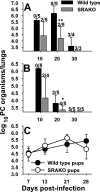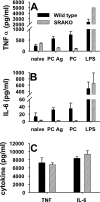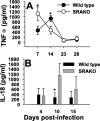Scavenger receptor A dampens induction of inflammation in response to the fungal pathogen Pneumocystis carinii
- PMID: 17548480
- PMCID: PMC1951997
- DOI: 10.1128/IAI.00393-07
Scavenger receptor A dampens induction of inflammation in response to the fungal pathogen Pneumocystis carinii
Abstract
Alveolar macrophages are the effector cells largely responsible for clearance of Pneumocystis carinii from the lungs. Binding of organisms to beta-glucan and mannose receptors has been shown to stimulate phagocytosis of the organisms. To further define the mechanisms used by alveolar macrophages for clearance of P. carinii, mice deficient in the expression of scavenger receptor A (SRA) were infected with P. carinii, and clearance of organisms was monitored over time. SRA-deficient (SRAKO) mice consistently cleared P. carinii faster than did wild-type control mice. Expedited clearance corresponded to elevated numbers of activated CD4(+) T cells in the alveolar spaces of SRAKO mice compared to wild-type mice. Alveolar macrophages from SRAKO mice had increased expression of CD11b on their surfaces, consistent with an activated phenotype. However, they were not more phagocytic than macrophages expressing SRA, as measured by an in vivo phagocytosis assay. SRAKO alveolar macrophages produced significantly more tumor necrosis factor alpha (TNF-alpha) than wild-type macrophages when stimulated with lipopolysaccharide in vitro but less TNF-alpha in response to P. carinii in vitro. However, upon in vivo stimulation, SRAKO mice produced significantly more TNF-alpha, interleukin 12 (IL-12), and IL-18 in response to P. carinii infection than did wild-type mice. Together, these data indicate that SRA controls inflammatory cytokines produced by alveolar macrophages in the context of P. carinii infection.
Figures






Similar articles
-
Activated pulmonary macrophages are insufficient for resistance against Pneumocystis carinii.Infect Immun. 1998 Jan;66(1):305-14. doi: 10.1128/IAI.66.1.305-314.1998. Infect Immun. 1998. PMID: 9423872 Free PMC article.
-
Exogenous heat-killed Escherichia coli improves alveolar macrophage activity and reduces Pneumocystis carinii lung burden in infant mice.Infect Immun. 2007 Jul;75(7):3382-93. doi: 10.1128/IAI.00174-07. Epub 2007 May 7. Infect Immun. 2007. PMID: 17485459 Free PMC article.
-
Passive immunization of neonatal mice against Pneumocystis carinii f. sp. muris enhances control of infection without stimulating inflammation.Infect Immun. 2004 Nov;72(11):6211-20. doi: 10.1128/IAI.72.11.6211-6220.2004. Infect Immun. 2004. PMID: 15501746 Free PMC article.
-
Mechanisms of defence in the lung: lessons from Pneumocystis carinii pneumonia.Sarcoidosis Vasc Diffuse Lung Dis. 2000 Jun;17(2):130-9. Sarcoidosis Vasc Diffuse Lung Dis. 2000. PMID: 10957761 Review.
-
Alveolar macrophage and glycoprotein responses to Pneumocystis carinii.Semin Respir Infect. 1998 Dec;13(4):339-47. Semin Respir Infect. 1998. PMID: 9872631 Review.
Cited by
-
Macrophage immunoregulatory pathways in tuberculosis.Semin Immunol. 2014 Dec;26(6):471-85. doi: 10.1016/j.smim.2014.09.010. Epub 2014 Oct 30. Semin Immunol. 2014. PMID: 25453226 Free PMC article. Review.
-
Terminalia bellirica (Gaertn.) Roxb. Extract and Gallic Acid Attenuate LPS-Induced Inflammation and Oxidative Stress via MAPK/NF-κB and Akt/AMPK/Nrf2 Pathways.Oxid Med Cell Longev. 2018 Nov 8;2018:9364364. doi: 10.1155/2018/9364364. eCollection 2018. Oxid Med Cell Longev. 2018. PMID: 30533177 Free PMC article.
-
Mechanism and regulatory function of CpG signaling via scavenger receptor B1 in primary B cells.J Biol Chem. 2009 Aug 21;284(34):22878-87. doi: 10.1074/jbc.M109.018580. Epub 2009 Jun 19. J Biol Chem. 2009. PMID: 19542230 Free PMC article.
-
Macrophage scavenger receptor 1 contributes to pathogenesis of fulminant hepatitis via neutrophil-mediated complement activation.J Hepatol. 2018 Apr;68(4):733-743. doi: 10.1016/j.jhep.2017.11.010. Epub 2017 Nov 14. J Hepatol. 2018. PMID: 29154963 Free PMC article.
-
SR-A regulates the inflammatory activation of astrocytes.Neurotox Res. 2014 Jan;25(1):68-80. doi: 10.1007/s12640-013-9432-1. Epub 2013 Oct 11. Neurotox Res. 2014. PMID: 24114771
References
-
- Becker, M., A. Cotena, S. Gordon, and N. Platt. 2006. Expression of the class A macrophage scavenger receptor on specific subpopulations of murine dendritic cells limits their endotoxin response. Eur. J. Immunol. 36:950-960. - PubMed
-
- Carmona, E. M., R. Vassallo, Z. Vuk-Pavlovic, J. E. Standing, T. J. Kottom, and A. H. Limper. 2006. Pneumocystis cell wall β-glucans induce dendritic cell costimulatory molecule expression and inflammatory activation through a Fas-Fas ligand mechanism. J. Immunol. 177:459-467. - PubMed
Publication types
MeSH terms
Substances
Grants and funding
LinkOut - more resources
Full Text Sources
Molecular Biology Databases
Research Materials
Miscellaneous

